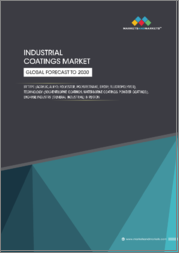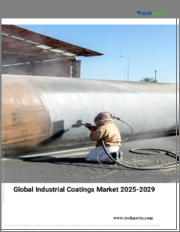
|
시장보고서
상품코드
1655632
산업용 페인트 및 코팅 시장 평가 : 제품 유형별, 용도별, 최종사용자별, 지역별, 기회 및 예측(2018-2032년)Industrial Paint and Coating Market Assessment, By Product Type, By Type, By Application, By End-user, By Region, Opportunities and Forecast, 2018-2032F |
||||||
세계 산업용 페인트 및 코팅 시장은 2025-2032년의 예측 기간 동안 3.45%의 연평균 복합 성장률(CAGR)을 나타내고, 2024년 1,014억 9,000만 달러에서 2032년 1,331억 3,000만 달러로 성장할 것으로 예상됩니다. 세계 산업용 도료 및 코팅 시장은 자동차, 항공우주, 건설, 제조 등의 분야에서 중요합니다. 이러한 도료는 제품과 환경을 보호할 뿐만 아니라 제품의 외관을 아름답게 만들어 줍니다. 지속가능성과 혁신에 대한 업계의 관심이 높아짐에 따라 고급, 내구성, 효율적이고 친환경적인 도료에 대한 수요는 계속 증가하고 있습니다. 이 시장을 형성하는 주요 트렌드는 수성 도료와 분체 도료이며, 그 주된 이유는 엄격한 환경 규제와 저 VOC 제품에 대한 소비자의 요구입니다. 또한, 배합 기술 및 도포 기술도 발전하고 있으며, 제조업체는 각 산업의 다양한 요구에 대응하는 고성능 도료를 제공할 수 있게 되었습니다.
또한, 자동차 시장은 여전히 보호 및 장식용 특수 도료에 대한 수요를 주도하고 있으며, 2022년 5월, BASF는 인도 망갈로르에 새로운 자동차 코팅 용도 센터를 확장했습니다. 이 최첨단 시설을 통해 바스프는 고객 솔루션 제공을 개선하고 자동차 코팅의 최신 기술을 개발할 수 있게 되었습니다. 이번 센터 확장은 인도에서 고급 코팅 솔루션에 대한 수요 증가에 대응하기 위한 전략적인 이유에서 비롯되었습니다.
목차
제1장 프로젝트의 범위와 정의
제2장 조사 방법
제3장 주요 요약
제4장 고객의 소리
- 응답자 인구통계
- 구입 결정시에 고려되는 요소
- 제품 유형
- 응모 요건
- 브랜드 평판
- 가격 경쟁력
제5장 세계의 산업용 페인트 및 코팅 시장 전망, 2018년-2032년
- 시장 규모 분석과 예측
- 금액별
- 수량별
- 시장 점유율 분석과 예측
- 제품 유형별
- 수성 기반
- 용제 기반
- 유형별
- 자동차 및 보수용 코팅
- 보호 코팅
- 분체 코팅
- 일반 산업용 코팅
- 기타
- 용도별
- OEM 및 특수 용도
- 건축
- 기타
- 최종사용자별
- 자동차
- 해양
- 일반 산업
- 기타
- 지역별
- 북미
- 유럽
- 아시아태평양
- 남미
- 중동 및 아프리카
- 시장 점유율 분석(주요 5개사 및 기타 - 금액별, 2024년), 기업별
- 제품 유형별
- 시장 맵 분석, 2024년
- 제품 유형별
- 유형별
- 용도별
- 최종사용자별
- 지역별
제6장 북미의 산업용 페인트 및 코팅 시장 전망, 2018년-2032년
- 시장 규모 분석과 예측
- 금액별
- 수량별
- 시장 점유율 분석과 예측
- 제품 유형별
- 수성 기반
- 용제 기반
- 유형별
- 자동차 및 보수용 코팅
- 보호 코팅
- 분체 코팅
- 일반 산업용 코팅
- 기타
- 용도별
- OEM 및 특수 용도
- 건축
- 기타
- 최종사용자별
- 자동차
- 해양
- 일반 산업
- 기타
- 국가별 점유율
- 미국
- 캐나다
- 멕시코
- 제품 유형별
- 시장 평가, 국가별
- 미국의 산업용 페인트 및 코팅 시장 전망, 2018-2032년
- 시장 규모 분석과 예측
- 시장 점유율 분석과 예측
- 캐나다
- 멕시코
- 미국의 산업용 페인트 및 코팅 시장 전망, 2018-2032년
모든 부문은 모든 지역과 지역을 대상으로 제공됩니다.
제7장 유럽의 산업용 페인트 및 코팅 시장 전망, 2018년-2032년
- 독일
- 프랑스
- 이탈리아
- 영국
- 러시아
- 네덜란드
- 스페인
- 터키
- 폴란드
제8장 아시아태평양의 산업용 페인트 및 코팅 시장 전망, 2018년-2032년
- 인도
- 중국
- 일본
- 호주
- 베트남
- 한국
- 인도네시아
- 필리핀
제9장 남미의 산업용 페인트 및 코팅 시장 전망, 2018년-2032년
- 브라질
- 아르헨티나
제10장 중동 및 아프리카의 산업용 페인트 및 코팅 시장 전망, 2018년-2032년
- 사우디아라비아
- 아랍에미리트(UAE)
- 남아프리카공화국
제11장 Porter의 Five Forces 분석
제12장 PESTLE 분석
제13장 시장 역학
- 시장 성장 촉진요인
- 시장이 해결해야 할 과제
제14장 시장 동향과 발전
제15장 사례 연구
제16장 경쟁 구도
- 시장 리더 주요 5개사의 경쟁 매트릭스
- 주요 5개 기업의 SWOT 분석
- 주요 10개 기업의 기업 상황
- The Sherwin-Williams Company
- 기업 개요
- 주요 경영진
- 제품 및 서비스
- 재무 상황(보고된 대로)
- 주요 시장 포커스와 지역 존재감
- 최근 동향/협업/파트너십/합병과 인수
- PPG Industries, Inc.
- AkzoNobel NV
- Nippon Paint Holdings Co., Ltd.
- RPM International Inc.
- Axalta Coating Systems, LLC
- BASF SE
- Kansai Paint Co., Ltd.
- Jotun A/S
- Hempel A/S
- The Sherwin-Williams Company
위에 언급된 기업은 시장 점유율에 따른 순위를 보유하지 않으며, 조사 작업 중 이용 가능한 정보에 따라 변경될 수 있습니다.
제17장 전략적 제안
제18장 리서치사에 대해 & 면책사항
LSH 25.03.06Global industrial paint and coating market is projected to witness a CAGR of 3.45% during the forecast period 2025-2032, growing from USD 101.49 billion in 2024 to USD 133.13 billion in 2032. The global industrial paint and coating market is important for sectors such as automotive, aerospace, construction, and manufacturing. These coatings enhance the cosmetic appearance of products, in addition to protecting them and the environment. With an increasing industry focus on sustainability and innovation, the demand for advanced, durable, efficient, and eco-friendly coatings continues to grow. Key trends that shape this market are water-based and powder coatings, mainly because of strict environmental regulations and the need for low-VOC products among consumers. In addition, formulation and application technologies have been advancing, and manufacturers can deliver high-performance coatings that cater to various needs of the industries.
In addition, the automotive market remains a main driver of the demand for protective and decorative specialties in coatings. In May 2022, BASF expanded its new Automotive Coatings Application Centre in Mangalore, India. Such a state-of-the-art facility makes it possible for the company to improve its delivery of customer solutions and develop the latest technology for automotive coating. This center expansion is for strategic reasons to meet the increasing requirements of high-grade coatings solutions in India.
Growing Focus on Sustainable Products Boosts Industrial Paint and Coating Demand
Industrial paint and coating market is mainly driven by demand heightened by sustainability, especially within the automotive segment. As consumer preference for environmentally friendly products is changing along with tightening environmental regulations, manufacturers are more motivated to innovate with new sustainable techniques. This fact can be explained by the growing demand for water-based and bio-based coatings that not only have low VOCs but also offer lower impacts during production and application.
Industry leaders are increasingly collaborating to help develop sustainable coating technologies. Corporations are looking into research and development to have high-performance coatings that meet sustainability criteria and still do not compromise on quality. Combining digital technology, such as color-matching systems, to increase efficiency in the application process further accelerates sustainability.
In February 2024, INEOS Automotive and BASF's Coatings division signed an agreement on a global automotive refinish body and paint development. For the next three years, BASF will help INEOS Automotive build its global body and paint program focusing on the highest level of industry standards and sustainable refinish solutions. The collaboration will help promote INEOS's Grenadier model, besides its new double-cab version, the Quartermaster, in different worldwide markets.
Rising Demand for High-Performance Marine Coatings Fuel Market Growth
An increased demand for efficient and durable marine coatings is driving growth in the industrial paint and coating market. Marine vessels, cargo ships, oil tankers, and naval fleets all function in very aggressive environments, with constant exposure to saltwater, extreme temperatures, and severe weather conditions. To increase vessel durability, decrease maintenance costs, and ensure operational efficiency, there has been an increased demand for superior anti-corrosion, anti-fouling, and fuel-saving properties of advanced marine coatings.
Stringent environmental regulations are advancing the requirement for eco-friendly marine coatings. Organizations such as the International Maritime Organization (IMO) have instituted strict guidelines requiring a reduction of harmful emissions into the atmosphere besides improving fuel efficiency. This brings about sustainable solutions in coating reduction of biofouling lowers drag resistance contributing to lower consumption of fuel besides carbon emissions. The increasing emphasis on sustainability within the shipping industry impels research and development into high-performance coatings for marine environments, specifically coatings that are free from harmful biocides.
In April 2024, WEG Coatings allied with Canadian company GIT Coatings to bolster its marine coatings supply in international markets. The collaboration is built upon shared innovation for increased shipping efficiency, reduced operating costs, and efficiency with a view toward sustainability. GIT specializes in graphene-based solutions that help contain fuel costs and cut carbon emissions. The goal of the partnership fits within these lines and is based on customized solutions and new product offerings, solely indicative of the responsible maintenance of technological developments in the maritime sector.
Dominance of Water-based Paint in Industrial Paint and Coating Market
The dominance of water-based industrial paints and coatings is prevalent as companies pay more attention to sustainability and responsibility towards the environment. These paints are formulated using water as a primary solvent and are considered better than solvent-based paints. Water-based coatings not only contribute to reducing hazardous emissions but also provide excellent performance characteristics, including durability, rapid drying times, and ease of application.
Significant reductions in VOC emissions are another substantial advantage of using water-based paints. These solvents are usually associated with emitting volatile organic compounds, which constitute a major ingredient in air pollution and various health problems. As consumers keep becoming more mindful of the green environment, sales of eco-friendly products are seen to increase considerably, compelling more manufacturers to add to their categories.
For instance, in January 2023, Asian Paints, a leading paint company in India, sanctioned USD 241.2 million for establishing a new unit dedicated to water-based paints. This facility will have the capacity to produce 400,000 kiloliters annually and feature advanced equipment designed to produce environmentally friendly paints and intermediates. This strategic investment not only reflects Asian Paint's commitment towards sustainability but also goes with the growing market demand for water-based decorative paints. Such initiatives signal a broader industry shift toward greener solutions, reinforcing the importance of water-based coatings in the future of industrial painting.
Asia Pacific to Witness Highest Growth Rate in Global Industrial Paint and Coating Market
Asia Pacific will continue to benefit from the highest growth rates in the industrial paint and coating market due to increased speedy industrialization, urbanization, and improved infrastructure projects. The countries involved include China, India, and Southeast Asian nations, which have been growing their markets due to increased demand from the automotive, construction, and general industrial sectors. Good governance policies, investment in manufacturing, and increased automobile production are additional factors propelling the expansion of markets within this region. Increased awareness of the merits of protective coatings, including corrosion resistance and durability benefits, facilitates greater general acceptance. Expansion by regional manufacturers as well as strategic initiatives from global players, bringing improved availability of products and technology, has been improving the growth of the market. Accelerating the growth of the market, a preference for more environmentally friendly and low-VOC coating comes from consumers who must meet stringent regulations.
For instance, in April 2023, Sherwin-Williams completed the divestiture of its China architectural paint business to Akzo Nobel N.V. This business is operating under the Huarun brand and was acquired by Sherwin-Williams in 2017 in connection with its purchase of Valspar. This business generates about USD100 million in annual revenue and employs approximately 300 people. This divestiture is in line with Sherwin-Williams' strategy of portfolio optimization while focusing on growth opportunities in the industrial coatings segment.
Future Market Scenario (2025 - 2032F)
With growing environmental awareness, the market is demanding more environment-friendly coatings. Consequently, manufacturing is expected to shift towards low-VOC and water-based paints, aligning with current sustainability goals.
The market is likely to evolve through advancements in technology. It is going to see more traction of nanotechnology and smart coatings that have advanced durability and self-cleaning capabilities. Such new-age solutions would attract industries demanding high-performance offerings.
Developing countries, specifically in Asia-Pacific and Africa, are fast industrializing and urbanizing. This growth will likely increase demand for industrial coatings in construction, auto, and manufacturing sectors, thereby offering many opportunities for expanded markets.
While the trend toward customization continues, it seems to be gaining momentum in offering customized solutions to specific industry requirements. Specialty coatings with unique properties such as corrosion and heat resistance or anti-microbial features will gain importance as industries look for product performance enhancements.
Key Players Landscape and Outlook
The industrial coatings market is moderately competitive with industry leaders such as Akzo Nobel, PPG Industries, and Sherwin-Williams taking the lead in the market through strategic initiatives that include mergers and acquisitions to achieve a greater share of the market and product range. A rise in focus toward eco-friendly as well as innovation-based coating solutions is compelling massive research and development spending, majorly in growth regions such as Asia-Pacific.
The market remains fragmented, with global merging as well as specialized regional players competing through different segments. Major companies rely on established brand positions, wide distribution networks, and integrated operations to attain competitive advantages. Besides this, vertical integration strategies are also being pursued to keep cost optimization and ensure raw material supplies.
As the industry continues to grow, companies are increasingly forming strategic partnerships to penetrate regional markets more effectively and share technological expertise. This is likely to continue, creating a dynamic environment for growth and innovation within the sector.
In September 2023, Nippon Paint Holdings (NPHD) decided to acquire shares in Nippon Paint (India) Private Limited (NPI), and Berger Nippon Paint Automotive Coatings Private Limited (BNPA). In this deal, NPHD will buy direct NPI shares and one of its subsidiary companies, the Nippon Paint Automotive Coatings (NPAC), will buy BNPA shares.
Table of Contents
1. Project Scope and Definitions
2. Research Methodology
3. Executive Summary
4. Voice of Customer
- 4.1. Respondent Demographics
- 4.2. Factors Considered in Purchase Decisions
- 4.2.1. Product Type
- 4.2.2. Application Requirements
- 4.2.3. Brand Reputation
- 4.2.4. Price Competitiveness
5. Global Industrial Paint and Coating Market Outlook, 2018-2032F
- 5.1. Market Size Analysis & Forecast
- 5.1.1. By Value
- 5.1.2. By Volume
- 5.2. Market Share Analysis & Forecast
- 5.2.1. By Product Type
- 5.2.1.1. Water-based
- 5.2.1.2. Solvent-based
- 5.2.2. By Type
- 5.2.2.1. Automotive and Refinish Coating
- 5.2.2.2. Protective Coating
- 5.2.2.3. Powder Coating
- 5.2.2.4. General Industrial Coating
- 5.2.2.5. Others
- 5.2.3. By Application
- 5.2.3.1. OEM and Special Purpose
- 5.2.3.2. Architectural
- 5.2.3.3. Others
- 5.2.4. By End-user
- 5.2.4.1. Automotive
- 5.2.4.2. Marine
- 5.2.4.3. General Industries
- 5.2.4.4. Others
- 5.2.5. By Region
- 5.2.5.1. North America
- 5.2.5.2. Europe
- 5.2.5.3. Asia-Pacific
- 5.2.5.4. South America
- 5.2.5.5. Middle East and Africa
- 5.2.6. By Company Market Share Analysis (Top 5 Companies and Others - By Value, 2024)
- 5.2.1. By Product Type
- 5.3. Market Map Analysis, 2024
- 5.3.1. By Product Type
- 5.3.2. By Type
- 5.3.3. By Application
- 5.3.4. By End-user
- 5.3.5. By Region
6. North America Industrial Paint and Coating Market Outlook, 2018-2032F*
- 6.1. Market Size Analysis & Forecast
- 6.1.1. By Value
- 6.1.2. By Volume
- 6.2. Market Share Analysis & Forecast
- 6.2.1. By Product Type
- 6.2.1.1. Water-based
- 6.2.1.2. Solvent-based
- 6.2.2. By Type
- 6.2.2.1. Automotive and Refinish Coating
- 6.2.2.2. Protective Coating
- 6.2.2.3. Powder Coating
- 6.2.2.4. General Industrial Coating
- 6.2.2.5. Others
- 6.2.3. By Application
- 6.2.3.1. OEM and Special Purpose
- 6.2.3.2. Architectural
- 6.2.3.3. Others
- 6.2.4. By End-user
- 6.2.4.1. Automotive
- 6.2.4.2. Marine
- 6.2.4.3. General Industries
- 6.2.4.4. Others
- 6.2.5. By Country Share
- 6.2.5.1. United States
- 6.2.5.2. Canada
- 6.2.5.3. Mexico
- 6.2.1. By Product Type
- 6.3. Country Market Assessment
- 6.3.1. United States Industrial Paint and Coating Market Outlook, 2018-2032F*
- 6.3.1.1. Market Size Analysis & Forecast
- 6.3.1.1.1. By Value
- 6.3.1.1.2. By Volume
- 6.3.1.2. Market Share Analysis & Forecast
- 6.3.1.2.1. By Product Type
- 6.3.1.2.1.1. Water-based
- 6.3.1.2.1.2. Solvent-based
- 6.3.1.2.2. By Type
- 6.3.1.2.2.1. Automotive and Refinish Coating
- 6.3.1.2.2.2. Protective Coating
- 6.3.1.2.2.3. Powder Coating
- 6.3.1.2.2.4. General Industrial Coating
- 6.3.1.2.2.5. Others
- 6.3.1.2.3. By Application
- 6.3.1.2.3.1. OEM and Special Purpose
- 6.3.1.2.3.2. Architectural
- 6.3.1.2.3.3. Others
- 6.3.1.2.4. By End-user
- 6.3.1.2.4.1. Automotive
- 6.3.1.2.4.2. Marine
- 6.3.1.2.4.3. General Industries
- 6.3.1.2.4.4. Others
- 6.3.1.2.1. By Product Type
- 6.3.1.1. Market Size Analysis & Forecast
- 6.3.2. Canada
- 6.3.3. Mexico
- 6.3.1. United States Industrial Paint and Coating Market Outlook, 2018-2032F*
All segments will be provided for all regions and countries covered
7. Europe Industrial Paint and Coating Market Outlook, 2018-2032F
- 7.1. Germany
- 7.2. France
- 7.3. Italy
- 7.4. United Kingdom
- 7.5. Russia
- 7.6. Netherlands
- 7.7. Spain
- 7.8. Turkey
- 7.9. Poland
8. Asia-Pacific Industrial Paint and Coating Market Outlook, 2018-2032F
- 8.1. India
- 8.2. China
- 8.3. Japan
- 8.4. Australia
- 8.5. Vietnam
- 8.6. South Korea
- 8.7. Indonesia
- 8.8. Philippines
9. South America Industrial Paint and Coating Market Outlook, 2018-2032F
- 9.1. Brazil
- 9.2. Argentina
10. Middle East and Africa Industrial Paint and Coating Market Outlook, 2018-2032F
- 10.1. Saudi Arabia
- 10.2. UAE
- 10.3. South Africa
11. Porter's Five Forces Analysis
12. PESTLE Analysis
13. Market Dynamics
- 13.1. Market Drivers
- 13.2. Market Challenges
14. Market Trends and Developments
15. Case Studies
16. Competitive Landscape
- 16.1. Competition Matrix of Top 5 Market Leaders
- 16.2. SWOT Analysis for Top 5 Players
- 16.3. Key Players Landscape for Top 10 Market Players
- 16.3.1. The Sherwin-Williams Company
- 16.3.1.1. Company Details
- 16.3.1.2. Key Management Personnel
- 16.3.1.3. Products and Services
- 16.3.1.4. Financials (As Reported)
- 16.3.1.5. Key Market Focus and Geographical Presence
- 16.3.1.6. Recent Developments/Collaborations/Partnerships/Mergers and Acquisition
- 16.3.2. PPG Industries, Inc.
- 16.3.3. AkzoNobel N.V.
- 16.3.4. Nippon Paint Holdings Co., Ltd.
- 16.3.5. RPM International Inc.
- 16.3.6. Axalta Coating Systems, LLC
- 16.3.7. BASF SE
- 16.3.8. Kansai Paint Co., Ltd.
- 16.3.9. Jotun A/S
- 16.3.10. Hempel A/S
- 16.3.1. The Sherwin-Williams Company
Companies mentioned above DO NOT hold any order as per market share and can be changed as per information available during research work.



















